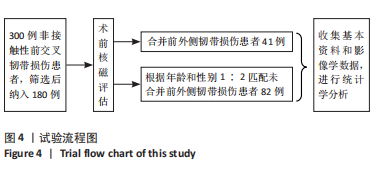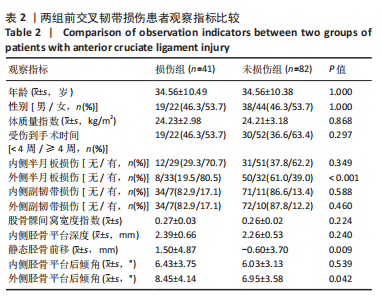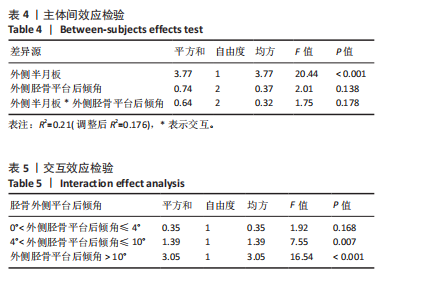[1] ARUNDALE AJH, SILVERS-GRANELLI HJ, MYKLEBUST G. ACL injury prevention: Where have we come from and where are we going? J Orthop Res. 2022;40(1):43-54.
[2] XU Z, MA L, LI R. Anatomic Double-Bundle and Single-Bundle Reconstructions Yield Similar Outcomes Following Anterior Cruciate Ligament Rupture: A Systematic Review and Meta-analysis. Arthroscopy. 2024;40(2):481-494.
[3] WANG LJ, ZENG N, YAN ZP, et al. Post-traumatic osteoarthritis following ACL injury. Arthritis Res Ther. 2020;22(1):57.
[4] ROTHRAUFF BB, JORGE A, DE SA D, et al. Anatomic ACL reconstruction reduces risk of post-traumatic osteoarthritis: a systematic review with minimum 10-year follow-up. Knee Surg Sports Traumatol Arthrosc. 2020;28(4):1072-1084.
[5] PARK YB, LEE HJ, CHO HC, et al. Combined Lateral Extra-Articular Tenodesis or Combined Anterolateral Ligament Reconstruction and Anterior Cruciate Ligament Reconstruction Improves Outcomes Compared to Isolated Reconstruction for Anterior Cruciate Ligament Tear: A Network Meta-analysis of Randomized Controlled Trials. Arthroscopy. 2023;39(3):758-776.e10.
[6] NAZZAL EM, KEELING LE, RYAN PM, et al. The Role of Lateral Extra-articular Tenodesis in Anterior Cruciate Ligament Reconstruction and Treatment of Rotatory Knee Instability: a Scoping Review. Curr Rev Musculoskelet Med. 2023;16(6):235-245.
[7] PARK JG, HAN SB, LEE CS, et al. Anatomy, Biomechanics, and Reconstruction of the Anterolateral Ligament of the Knee Joint. Medicina (Kaunas). 2022;58(6):786.
[8] CLAES S, VEREECKE E, MAES M, et al. Anatomy of the anterolateral ligament of the knee. J Anat. 2013;223(4):321-328.
[9] SONG GY, ZHANG H, WANG QQ, et al. Risk Factors Associated With Grade 3 Pivot Shift After Acute Anterior Cruciate Ligament Injuries. Am J Sports Med. 2016;44(2):362-369.
[10] DELALOYE JR, MURAR J, KOCH PP, et al. Combined anterior cruciate ligament and anterolateral ligament lesions: from anatomy to clinical results. Ann Joint. 2018;3:82.
[11] BLANKE F, BOLJEN M, LUTTER C, et al. Does the anterolateral ligament protect the anterior cruciate ligament in the most common injury mechanisms? A human knee model study. Knee. 2021;29:381-389.
[12] NERI T, DABIRRAHMANI D, BEACH A, et al. Different anterolateral procedures have variable impact on knee kinematics and stability when performed in combination with anterior cruciate ligament reconstruction. J ISAKOS. 2021;6(2):74-81.
[13] KOGA H, NAKAMAE A, SHIMA Y, et al. Mechanisms for noncontact anterior cruciate ligament injuries: knee joint kinematics in 10 injury situations from female team handball and basketball. Am J Sports Med. 2010;38(11):2218-2225.
[14] CHOI NH, LEE DM, SHIN HJ, et al. Combined Anterolateral Ligament and Anterior Cruciate Ligament Injury Is Associated With Increased Lateral Femoral Condyle Ratio. Arthroscopy. 2023;39(5):1235-1241.
[15] BARGAGLIOTTI M, BENAZZO F, BELLEMANS J, et al. The Role of the Posterolateral Tibial Slope in the Rotational Instability of the Knee in Patients Affected by a Complete Isolated Anterior Cruciate Ligament Injury: Its Value in the Decision-Making Process during the Anterolateral Ligament Reconstruction. Joints. 2020;7(3):78-83.
[16] 赵良功.一种在核磁共振影像中分辨膝关节前外侧韧带的方法[J].甘肃医药,2020,39(5):445-446+452.
[17] KOW RY, LOW CL, SIRON BAHAROM KN, et al. MRI Evaluation of Anterolateral Ligament of the Knee: A Cross-Sectional Study in Malaysia. Cureus. 2021;13(6):e15758.
[18] KIZILGÖZ V, SIVRIOĞLU AK, ULUSOY GR, et al. Analysis of the risk factors for anterior cruciate ligament injury: an investigation of structural tendencies. Clin Imaging. 2018;50:20-30.
[19] PARK JS, NAM DC, KIM DH, et al. Measurement of Knee Morphometrics Using MRI: A Comparative Study between ACL-Injured and Non-Injured Knees. Knee Surg Relat Res. 2012;24(3):180-185.
[20] HASHEMI J, CHANDRASHEKAR N, GILL B, et al. The geometry of the tibial plateau and its influence on the biomechanics of the tibiofemoral joint. J Bone Joint Surg Am. 2008;90(12):2724-2734.
[21] LIAN J, NOVARETTI JV, SHEEAN AJ, et al. Static Lateral Tibial Plateau Subluxation Predicts High-Grade Rotatory Knee Laxity in Anterior Cruciate Ligament-Deficient Knees. Am J Sports Med. 2019;47(2): 277-284.
[22] SONG GY, ZHANG H, ZHANG J, et al. Excessive Preoperative Anterior Tibial Subluxation in Extension Is Associated With Inferior Knee Stability After Anatomic Anterior Cruciate Ligament Reconstruction. Am J Sports Med. 2020;48(3):573-580.
[23] MISIR A, UZUN E, SAYER G, et al. Anatomic Factors Associated With the Development of an Anterior Cruciate Ligament Rerupture in Men: A Case-Control Study. Am J Sports Med. 2022;50(12):3228-3235.
[24] HUDEK R, SCHMUTZ S, REGENFELDER F, et al. Novel measurement technique of the tibial slope on conventional MRI. Clin Orthop Relat Res. 2009;467(8):2066-2072.
[25] GETGOOD A, BROWN C, LORDING T, et al. The anterolateral complex of the knee: results from the International ALC Consensus Group Meeting. Knee Surg Sports Traumatol Arthrosc. 2019;27(1):166-176.
[26] LEE JK, SEO YJ, JEONG SY, et al. Biomechanical function of the anterolateral ligament of the knee: a systematic review. Knee Surg Relat Res. 2020;32(1):6.
[27] HODEL S, TORREZ C, FLURY A, et al. Tibial internal rotation in combined anterior cruciate ligament and high-grade anterolateral ligament injury and its influence on ACL length. BMC Musculoskelet Disord. 2022;23(1):262.
[28] BEDI A, MUSAHL V, LANE C, et al. Lateral compartment translation predicts the grade of pivot shift: a cadaveric and clinical analysis. Knee Surg Sports Traumatol Arthrosc. 2010;18(9):1269-1276.
[29] HELITO CP, HELITO PVP, LEÃO RV, et al. Anterolateral ligament abnormalities are associated with peripheral ligament and osseous injuries in acute ruptures of the anterior cruciate ligament. Knee Surg Sports Traumatol Arthrosc. 2017;25(4):1140-1148.
[30] SONG GY, ZHANG H, WU G, et al. Patients with high-grade pivot-shift phenomenon are associated with higher prevalence of anterolateral ligament injury after acute anterior cruciate ligament injuries. Knee Surg Sports Traumatol Arthrosc. 2017;25(4):1111-1116.
[31] HELITO PVP, HELITO CP, RODRIGUES MB. Anterolateral ligament MRI of the knee in ACL injuries: MRI abnormalities association with instability. Eur Radiol. 2023;33(2):1456-1464.
[32] LEE DW, LEE JH, KIM JN, et al. Evaluation of Anterolateral Ligament Injuries and Concomitant Lesions on Magnetic Resonance Imaging After Acute Anterior Cruciate Ligament Rupture. Arthroscopy. 2018; 34(8):2398-2406.
[33] VAN DYCK P, CLOCKAERTS S, VANHOENACKER FM, et al. Anterolateral ligament abnormalities in patients with acute anterior cruciate ligament rupture are associated with lateral meniscal and osseous injuries. Eur Radiol. 2016;26(10):3383-3391.
[34] SHYBUT TB, VEGA CE, HADDAD J, et al. Effect of lateral meniscal root tear on the stability of the anterior cruciate ligament-deficient knee. Am J Sports Med. 2015;43(4):905-911.
[35] MUSAHL V, CITAK M, O’LOUGHLIN PF, et al. The effect of medial versus lateral meniscectomy on the stability of the anterior cruciate ligament-deficient knee. Am J Sports Med. 2010;38(8):1591-1597.
[36] HELITO CP, HELITO PV, BONADIO MB, et al. Correlation of Magnetic Resonance Imaging With Knee Anterolateral Ligament Anatomy: A Cadaveric Study. Orthop J Sports Med. 2015;3(12):2325967115621024.
[37] KIM JN, PARK HJ, KIM MS, et al. Prevalence of anterolateral ligament injuries and lateral meniscus tear on MR imaging in patients with both-bundle tear vs. selective bundle incomplete tear of the anterior cruciate ligament. Eur Radiol. 2022;32(6):3954-3962.
[38] AHN JH, LEE SK, MUN JW, et al. Degree of Anterolateral Ligament Injury Impacts Outcomes After Double-Bundle Anterior Cruciate Ligament Reconstruction. Arthroscopy. 2021;37(1):222-230.
[39] LORDING T, CORBO G, BRYANT D, et al. Rotational Laxity Control by the Anterolateral Ligament and the Lateral Meniscus Is Dependent on Knee Flexion Angle: A Cadaveric Biomechanical Study. Clin Orthop Relat Res. 2017;475(10):2401-2408.
[40] MICICOI G, JACQUET C, KHAKHA R, et al. Femoral and Tibial Bony Risk Factors for Anterior Cruciate Ligament Injuries Are Present in More Than 50% of Healthy Individuals. Am J Sports Med. 2021;49(14):3816-3824.
[41] MISIR A, SAYER G, UZUN E, et al. Individual and Combined Anatomic Risk Factors for the Development of an Anterior Cruciate Ligament Rupture in Men: A Multiple Factor Analysis Case-Control Study. Am J Sports Med. 2022;50(2):433-440.
|



